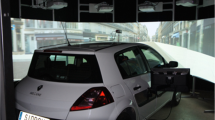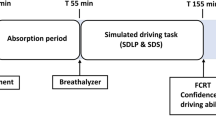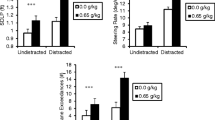Abstract
Rationale
Alcohol is the most frequently detected substance in fatal automobile crashes, but its precise mode of action is not always clear.
Objective
The present study was designed to establish the influence of blood alcohol concentration as a function of the complexity of the scenarios. Road scenarios implying automatic or controlled driving performances were manipulated in order to identify which behavioral parameters were deteriorated.
Method
A single blind counterbalanced experiment was conducted on a driving simulator. Sixteen experienced drivers (25.3 ± 2.9 years old, 8 men and 8 women) were tested with 0, 0.3, 0.5, and 0.8 g/l of alcohol. Driving scenarios varied: road tracking, car following, and an urban scenario including events inspired by real accidents. Statistical analyses were performed on driving parameters as a function of alcohol level.
Results
Automated driving parameters such as standard deviation of lateral position measured with the road tracking and car following scenarios were impaired by alcohol, notably with the highest dose. More controlled parameters such as response time to braking and number of crashes when confronted with specific events (urban scenario) were less affected by the alcohol level.
Conclusion
Performance decrement was greater with driving scenarios involving automated processes than with scenarios involving controlled processes.



Similar content being viewed by others
Notes
In the DRUID project, the objective was to dispose of baseline impairments due to different levels of alcohol for comparison with impairments due to other licit and illicit drugs.
References
Andersen GJ, Sauer CW (2007) Optical information for car following: the driving by visual angle (DVA) model. Hum Factors 49:878–896
Arnedt JT, Wilde GJS, Munt PW, MacLean AW (2001) How do prolonged wakefulness and alcohol compare in the decrements they produce on a simulated driving task? Accid Anal Prev 33:337–344
Berthelon C, Perrin C, Aillerie I, Espié S (2011) Methodology to introduce scenarios of accident in driving simulators. Interest for the analysis of drivers’ behavior. Proceedings of the third conference Road and Safety Simulation, Indianapolis, 14–16 septembre2011. http://onlinepubs.trb.org/onlinepubs/conferences/2011/RSS
Biecheler-Fretel MB, Peytavin JF, the SAM group, Facy F, Martineau H (2008) SAM survey on “drugs and fatal accidents”: search of substances consumed and comparison between drivers involved under the influence of alcohol or cannabis. Traffic Inj Prev 9:11–21
Bisby JA, Leitz JR, Morgan CJA, Curran HV (2009) Decreases in recollective experience following acute alcohol: a dose–response study. Psychopharmacology 208(1):67–74
Blomberg RD, Peck RC, Moskowitz H, Burns M, Fiorentino D (2009) The Long Beach/Fort Lauderdale relative risk study. J Saf Res 40(4):285–292
Borkenstein RF, Crowther RF, Shumate WB, Ziel WB, Zylinan R (1964) The role of the drinking driver in traffic accidents (The Grand Rapids Study), 2nd end. Blutalkohol 11(Suppl.1)
Brady JE, Li G (2012) Prevalence of alcohol and other drugs in fatally injured drivers. Addiction. doi:10.1111/j.1360-0443.2012.03993.x
Brookhuis KA (1998) How to measure driving ability under influence of alcohol and drugs, and why. Hum Psychopharmacol 13:S64–S69
Brookhuis KA, De Waard D, Fairclough SH (2003) Criteria for driver impairment. Ergonomics 46:433–445
Damm L, Nachtergaële C, Meskali M, Berthelon C (2011) The evaluation of traditional and early driving learning with simulated accident scenarios. Hum Factors 53(4):323–337
Espie S, Auberlet JM (2007) ARCHISIM: a behavioral multi-actors traffic simulation model for the study of a traffic system including ITS aspects. Int J ITS Res 5(1):7–16
Fillmore MT, Blackburn JS, Harrison LR (2008) Acute disinhibiting effects of alcohol as a factor in risky driving behaviour. Drug Alcohol Dependence 95(1–2):97–106
Fisk AD, Schneider W (1982) Type of task practice and time-sharing activities predict performance deficits due to alcohol ingestion. Proceedings of the Human Factors society, 21:926–930
Harrison ELR, Fillmore MT (2011) Alcohol and distraction interact to impair driving performance. Drug Alcohol Dependence 117:31–37
Helland A, Jenssen GD, Lervåg LD, Westin AA, Moen T, Sakshaug K, Lydersen S, Mørland J, Slørdal L (2013) Comparison of driving simulator performance with real driving after alcohol intake: a randomised, single blind, placebo-controlled, cross-over trial. Accid Anal Prev 53:9–16
Holloway FA (1995) Low-dose alcohol effects on human behaviour and performance. Alcohol Drugs Driving 11:39–56
Huemer AK, Vollrath M (2010) Alcohol-related impairment in the Lane Change Task. Accid Anal Prev 42:1983–1988
Kalmen H, Gustafson R (1998) Alcohol and desinhibition. Eur Addiction Res 4:150–162
Keall MD, Frith WJ, Patterson TL (2004) The influence of alcohol, age, and number of passengers on the night-time risk of driver fatal injury in New Zealand. Accid Anal Prev 36:49–62
Koelega HS (1995) Alcohol and vigilance performance: a review. Psychopharmacology 118:233–249
Krüger HP (1993) Effects of low alcohol dosages: a review of the literature. In: Utselmann HD, Berghaus G, Kroj G (eds) Alcohol, drugs and traffic safety-T92: Proceeding of the 12th International Conference on Alcohol, Drugs and Traffic Safety, Cologne, 28 september–2 October 1992, Verlag TUV Rheinland, pp 763–778
Kuypers KP, Samyn N, Ramaekers JG (2006) MDMA and alcohol effects, combined and alone, on objective and subjective measures of actual driving performance and psychomotor function. Psychopharmacology 1987(4):467–475
Lenné MG, Dietze PM, Triggs TJ, Walmsley S, Murphy B, Redman JN (2010) The effects of cannabis and alcohol on simulated arterial driving: influences of driving experience and task demand. Accid Anal Prev 42:859–866
Leung S, Starmer G (2005) Gap acceptance and risk-taking by young and mature drivers, both sober and alcohol-intoxicated, in a simulated driving task. Accid Anal Prev 37:1056–1065
Leung S, Croft RJ, Jackson ML, Howard ME, Mckenzie RJ (2012) A comparison of the effect of mobile phone use and alcohol consumption on driving simulation performance. Traffic Inj Prev 13(6):566–574
Liu CC, Hosking SG, Lenné MG (2009) Predicting driver drowsiness using vehicle measures: recent insights and future challenges. J Saf Res 40:239–245
Louwerens JM, Gloerich ABM, d Vries G, Brookhuis KA, O’Hanlon JF (1987) The relationship between drivers’ blood alcohol concentration (BAC) and actual driving performance during high speed travel. In: Noordzig PC, Roszbach R (eds) Alcohol, drugs and traffic safety—T86. Elsevier Science Publishers B.V., Amsterdam, pp 183–186
Meskali M, Berthelon C, Marie S, Denise P, Bocca ML (2009) Residual effects of hypnotics drugs in aging drivers submitted to simulated scenarios of accidents: an exploratory study. Psychopharmacology 207(3):461–467
Mets M, Kuipers E, de Senerpont Domis LM, Leenders M, Olivier B, Verster J (2011) Effects of alcohol on highway driving in the STISIM driving simulator. Hum Psychopharmacol Clin Exp 26(6):434–439
Michon JA (1985) A critical review of driver behaviour models: what do we know, what should we do. In: Evans L, Schwing RC (eds) Human behaviour and traffic safety. Plenum, New York, pp 485–520
Mørland J, Steentoft A, Simonsen KW, Ojanperä I, Vuori E, Magnusdottir K, Kristinsson J, Ceder G, Kronstrand R, Christophersen A (2011) Drugs related to motor vehicle crashes in northern European countries: a study of fatally injured drivers. Accid Anal Prev 43:1920–1926
Moskowitz H, Fiorentino D (2000) A review of the literature on the effects of low doses of alcohol on driving related skills. National Highway Traffic Safety Administration, Washington, Report DOT HS 809 028
Moskowitz H, Burns MM, Williams AF (1985) Skills performance at low blood alcohol levels. J Stud Alcohol 46:482–485
Movig KLL, Mathijssen MPM, Nagel PHA, van Egmond T, de Gier JJ, Leufkens HGM, Egberts ACG (2004) Psychoactive substance use and the risk of motor vehicle accidents. Accid Anal Prev 36:631–636
Ogden EJD, Moskowitz H (2004) Effects of alcohol and other drugs on driver performance. Traffic Inj Prev 5:185–198
O’Hanlon JF, Volkerts ER (1986) Hypnotics and actual driving performance. Acta Psychiatr Scand 332([Suppl]):95–104
O’Hanlon JF, Haak TW, Blauw GJ, Riemersma JBJ (1982) Diazepam impairs lateral position control in highway driving. Science 217:79–81
Owens K, Ramaekers JG (2009) Drugs, driving, and models to measure driving impairment. In: Verster et al (eds) Drugs, driving and traffic safety. Birkhäuser Verlag AG, Basel–Boston–Berlin, pp 43–58
Parks V, Leister C, Patat A, Troy S, Vermeeren A, Volkerts ER, Verster JC (2002) Effect of ethanol at a blood alcohol concentration of 0.4 g/l on actual driving and memory. Eur Neuropsychopharmacol 12:432–433
Peck RC, Gebers MA, Voas RB, Romano E (2008) The relationship between blood alcohol concentration (BAC), age, and crash risk. J Saf res 39:311–319
Philip P, Sagaspe P, Moorec N, Taillard J, Charles A, Guilleminault C, Bioulac B (2005) Fatigue, sleep restriction and driving performance. Accid Anal Prev 37:473–478
Phillips DP, Brewer KM (2011) The relationship between serious injury and blood alcohol concentration (BAC) in fatal motor vehicle accidents: BAC = 0.01 % is associated with significantly more dangerous accidents than BAC = 0.00 %. Addiction 106(9):1614–1622
Ramaekers JG, O’Hanlon JF (1994) Acrivastine, terfenadine and diphenhydramine effects on driving performance as a function of dose and time after dosing. Eur J Clin Pharmacol 47:261–266
Ronen A, Chassidima HS, Gershona P, Parmeta Y, Rabinovicha A, Bar-Hamburgerb R, Cassutoa Y, Shinara D (2010) The effect of alcohol, THC and their combination on perceived effects, willingness to drive and performance of driving and non-driving tasks. Accid Anal Prev 42:1855–1865
Simons R, Martens M, Ramaekers J, Krul A, Klöpping-Ketelaars I, Skopp G (2012) Effects of dexamphetamine with and without alcohol on simulated driving. Psychopharmacology 222:391–399
Skurtveit S, Abotnes B, Christophersen SA (2002) Drugged drivers in Norway with benzodiazepine detections. Forensic Sci Int 125:75–82
Tiplady B, Degia A, Dixon P (2005) Assessment of driver impairment: Evaluation of a two-choice tester using alcohol. Transp Res Part F 8:299–310
Vakulin A, Baulk SD, Catcheside PG, Anderson R, van den Heuvel CJ, Banks S, McEvoy RD (2007) Effects of moderate sleep deprivation and low-dose of alcohol on driving simulator performance and perception in young men. Sleep 30(10):1327–1333
Veldstra JL, Brookhuis KA, De Ward D, Molmans BHW, Verstraete AG, Skopp G, Jantos R (2012) Effects of alcohol (BAC 5‰) and ecstasy (MDMA 100 mg) on simulated driving performance and traffic safety. Psychopharmacology 222(3):377–390
Vermeeren A (2004) Residual effects of hypnotics: epidemiology and clinical implications. CNS Drugs 18:297–328
Verster JC, Ramaekers JG (2009) The on the road driving test. In: Verster et al. (Eds.), Drugs, driving and traffic safety. Birkhäuser Verlag AG, Basel-boston-Berlin, 2009, pp 83–92
Verster JC, Roth T (2011) Standard operation procedures for conducting the on-the-road driving test, and measurement of the standard deviation of lateral position (SDLP). Int J Gen Med 4:359–371
Verster JC, Roth T (2012a) Predicting psychopharmacological drug effects on actual driving performance (SDLP) from psychometric tests measuring driving-related skills. Psychopharmacology 220(2):293–301
Verster JC, Roth T (2012b) Vigilance decrement during the on-the-road driving tests: the importance of time-on-task in psychopharmacological research. Accid Anal Prev. doi:10.1016/j.aap.2012.10.005
Verster JC, Wester AE, Goorden M, van Wieringen J, Olivier B, Volkerts ER (2009) Novice drivers’ performance after different alcohol dosages and placebo in the divided-attention steering stimulator (DASS). Psychopharmacology 204:127–133
Vingilis E, MacDonald S (2004) Review: drugs and traffic collisions. Traffic Inj Prev 5:1–11
Walsh M, De Gier JJ, Christopherson AS, Verstraete AG (2004) Drugs and driving. Traffic Inj Prev 5:241–253
West R, Wilding J, French D, Kemp R, Irving A (1993) Effect of low and moderate level doses of alcohol on driving hazard perception latency and driving speed. Addiction 88:527–532
Williams EJ (1949) Experimental designs balanced for the estimation of residual effects of treatments. Aust J Sci Res 2(3):149–168
Zador PL, Krawchuk SA, Voas RB (2000) Relative risk of fatal crash involvement by BAC, age and gender. US Department of Transportation National Highway Safety Administration (DOT HS 809 050) April, 2000
Acknowledgments
This research was partly funded by the TREN-05-FP6TR-SO7.61320-518404-Druid project and partly funded by IFSTTAR. We would like to thank the IFSTTAR simulation team (LEPSIS: Laboratoire Exploitation, Perception, Simulateurs et Simulations), notably Isabelle Aillerie and Fabrice Vienne, for designing the displays. We would also like to thank Sylvie Hirt, Claudine Nachtergaële, and Mohamed Meskali for their help and assistance for the simulator-based data collection and processing.
Author information
Authors and Affiliations
Corresponding author
Rights and permissions
About this article
Cite this article
Berthelon, C., Gineyt, G. Effects of alcohol on automated and controlled driving performances. Psychopharmacology 231, 2087–2095 (2014). https://doi.org/10.1007/s00213-013-3352-x
Received:
Accepted:
Published:
Issue Date:
DOI: https://doi.org/10.1007/s00213-013-3352-x




